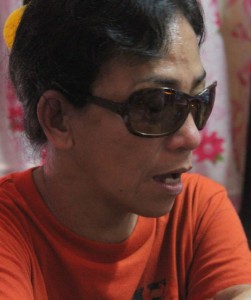
NO INCOME. Cleotilde Orihenes suffers from sore eyes and misses earning from selling banana cue. She saves a quarter of the family’s daily income for the school allowance of her son, Lester. (davaotoday.com by Medel Hernani)
The high cost of education has worsened as the average Filipino family struggles on how to send their children to school using modest income.
By JOHN RIZLE L. SALIGUMBA
Davao Today
DAVAO CITY, Philippines — To earn a college degree in nursing in four years, one needs to shell out at least PhP 285, 344 (US$ 6,289); for those interested in engineering and architecture majors and accountancy, one needs at least PhP 330,000 (US$ 7, 632).
And with another round of tuition fee increase — like the 150 percent increase to be imposed by Brokenshire College, a private nursing school — education has become a more expensive endeavor. Hundreds of its students walked out January 13, to protest the hike. Students from other schools are also gearing up for bigger mobilizations.
The high cost of education has worsened as the average Filipino family struggles on how to send their children to school using modest income.
Cleotilde Orihenes, 45, and husband Joselito, dreams of seeing their son Lester getting a college degree. They are banana cue (skewered fried bananas) vendors who earn about PhP 400 (US$ 9) a day. Their son, Lester, 22, is a third year Marine Transportation student at the Davao Merchant Marine Academy College of Southern Philippines.
They tried, but failed to secure a scholarship grant by the city government and by a congressman. Says Orihenes, “Sa iskwelehan naa man to, pero naluya siya kay mopasok siya’g scholar pero mobalik siya og first year. Sa pulitiko pud, maabtan nalang og enrolment kay sige’g balik-balik.” (The school has offered scholarship grants. But he was discouraged because he was required to repeat first year. It was also difficult to apply for scholarship offered by a politician. They would ask you to go back to them, again and again, until you’d reached the enrollment time for the next school year.)
Lester had no choice but to stop schooling and applied for a part-time job at a mall under its working-student program. There, he was required to spend six hours of work and would be paid with PhP 205 (US$ 4.73) per day or PhP 5,200-P5,500 (US$ 120-127) per month — just enough to pay for his tuition and other fees for one semester.
Orihenes said her son’s tuition and other fees amount to PhP 10,000-15,000 (US$ 230-346) per semester excluding other school expenses like projects. If other expenses are to be included like transportation, food and school needs, they need to generate PhP 5,000 (US$ 116) monthly for Lester alone.
Revive Study Now, Pay later
The plight of the Orihenes is shared by other struggling families.
For this reason, Representative Raymond Palatino of the partylist Kabataan, has asked the Commission on Higher Education to revive and expand the “Study Now, Pay Later,” a loan program for the students. “In our country, scholarship programs are not meeting the actual cost of education. Student loans do not cover for daily expenses such as lodging and transportation.”
The problem stems from the small budget for education. Palatino said the PhP 21.8 billion (US$ 0.5 billion) budget proposal is barely half of what state universities and colleges actually require for effective operations in 2012. He filed a petition in the House of Representatives’ committee on appropriations last September seeking a tertiary education budget of PhP 45.8 billion (US$ 1.06 billion) for this year.
Popular courses like nursing and engineering are costlier in private schools.
For eight semesters with 18 units of class load per semester, one has to payPhP 125,344 (US$ 2,906) to get a degree for Bachelor of Science in Nursing. The amount covers for tuition fees alone. With miscellaneous fees at PhP 15,000-PhP 20,000 (US$ 348 – US$ 463) per semester for clinical experience, the total amount would total to PhP 285,344 (US$ 6,289). Engineering which is a five-year course, excluding summer class, costs at least PhP 332,749.5 (US$ 7,632). For an average class load of 21 units, tuition fee for an engineering course would reach PhP 182,749.5 (US$4,242) and a total of PhP 150,000 (US$3,481) for miscellaneous fees.
As the state-funded scholarship program hits a snag, students make do with university grants.

WORKING STUDENT. Ana heads to the University of Mindanao, where she works as a student-assistant. (davaotoday.com by Medel Hernani
Ana (real name withheld), a student-assistant in the University of Mindanao, says she only has to pay for the remaining 25 percent of her tuition, amounting to PhP 2,500 (US$ 58) and PhP 5,000 (US$ 115) for the miscellaneous fees. The cost is still high for her parents, peasants in Banaybanay, Davao Oriental, who earn about PhP 70,000 (US$ 1,614) in one cropping or spread within five months. She has to shell out another PhP 4,000-5,000 (US$ 92-115) monthly for her other expenses.
Without her scholarship, Ana said her parents would have to shell out PhP 30,000-35,000 (US$ 692-807) per semester for her schooling — or half of the family’s budget for one cropping.
Ana said she also tried applying for various scholarship grants but to no avail.
Education as a right
“Libreng edukasyon ba, nga matabangan ang mga kabataan, labi na tong mga interesado gyud nga dili kaayo, nga modragweyt, di kaayo madak-an. Pero ang gubyerno karon ipit kaayo, di jud na mahatag na ba, moagi pa gyud nag gubot na.” (Free education that means helping the youth go to school especially those who are really interested. That education will be accessible for them. But the current government is so difficult, it won’t give in, it has to go through a rough process.)
Ana looks at it rather differently. “Kung naa kay kwarta, right siya. Kung wala, dili siya right. Naningkamot ko ug sa akong family naeffort.” (It’s a right if you can afford education. It’s not, if you can’t. It will depend on me and my family’s effort.)
More than palliative measures, Joselito Orihenes believes that no new program of the government can solve the problem. “Magsamot tag kalisud ani. Matuwid na daan? Ah, Wala! Kung di mausab ni atong sistema. Wala.” (We will suffer more. Righteous path? (of the aquino government), that’s nothing if our system will not be changed.”
As the problem on education and employment continues to hound them, students still want to earn a degree.
Ana doesn’t care if she joins the large number of underemployed for as long as she finishes school and gets a degree. She says she wants to get a job at a public school.
“Makatrabaho, makatabang sa amo. Mao nay gusto ni Lester” (To get a job and help us. That is what Lester wants.),” says Orihenes parents. However, the fourth year of Lester’s course involves apprenticeship in international cruise ships. And this means more costs, more expenses. (John Rizle L. Saligumba/davaotoday.com)
budget-cut, congressman palatino, cost of education, Education, first quarter storm, kabataan partylist, miscellaneous fees, national youth week, pay later, Poverty, study now, tuition, working students









